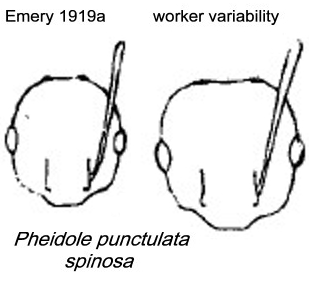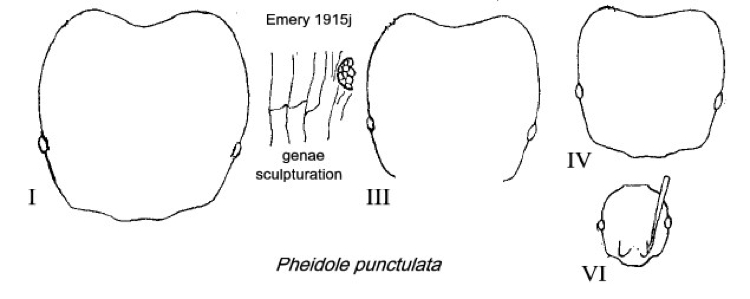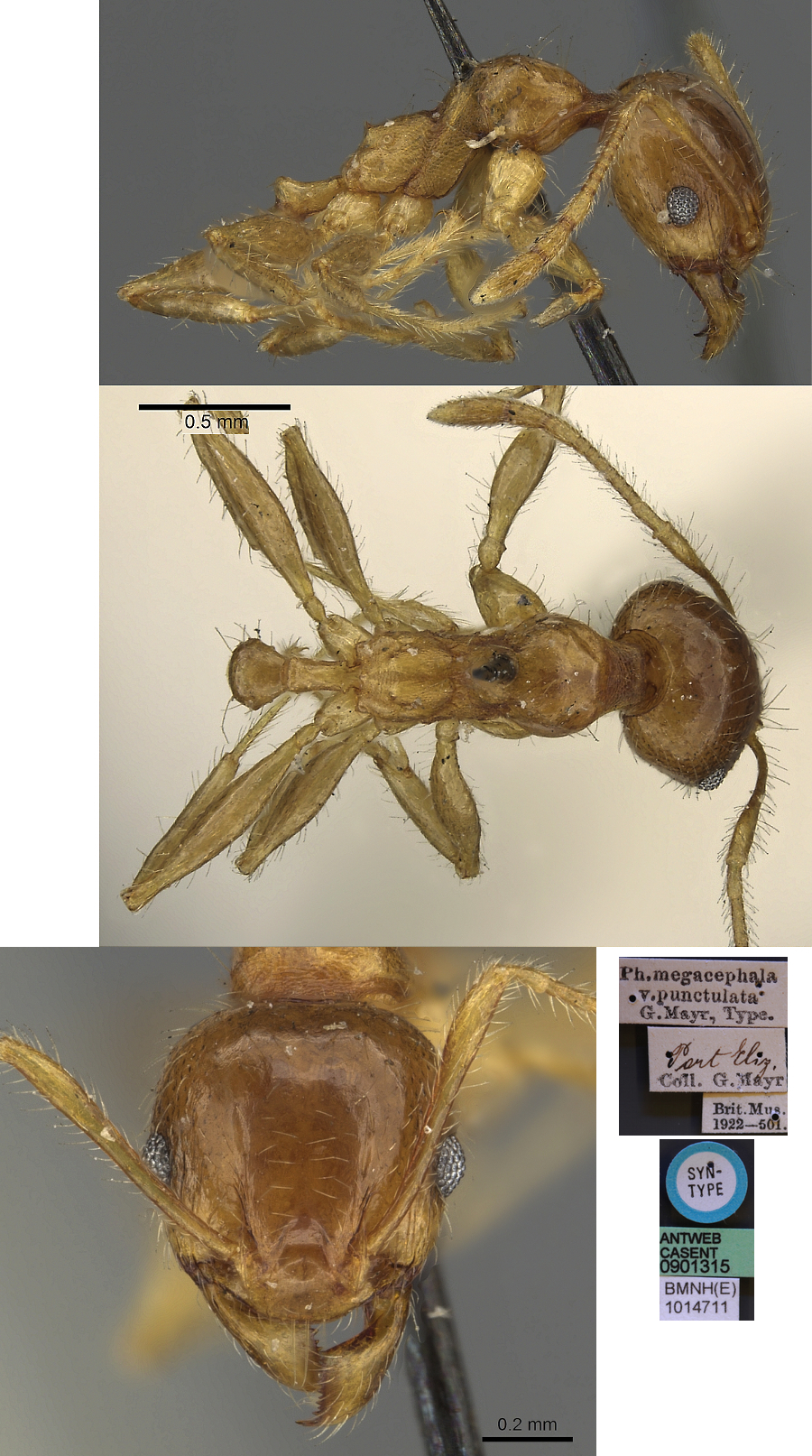Pheidole punctulata Mayr
  Type location South
Africa (Pheidole punctulata
nov. spec., Mayr, 1866b: 899, major; Arnold, 1920a: 421, minor, queen
& male) from Caffernland, Holm Museum - see below Type location South
Africa (Pheidole punctulata
nov. spec., Mayr, 1866b: 899, major; Arnold, 1920a: 421, minor, queen
& male) from Caffernland, Holm Museum - see below
all forms described (see Bolton, 1995)  . .
All of the following "subspecies" are readily separable and distinct
and, so, in my opinion, form species in their own right:
Pheidole
atrox (Pheidole
punctulata Mayr r. Atrox
n. stirps, Forel, 1913b: 328, major, minor &
queen; with junior synonym inquilina, "Pheidole inquilina n. sp. (?)",
Forel, 1914d: 240, minor,
from Zimbabwe) from Za´re, Lumbumbashi
[Elizabethville], by J. Bequaert
Pheidole
subatrox (Pheidole
punctulata Mayr v. subatrox
n. var., Santschi, 1937g: 76, major & minor) from Za´re,
Stanleyville, ex Reichensperger
Pheidole spinosa (Forel, 1891b: major
& minor; illustrated by Emery, 1919a) from Madagascar - see
http://www.antweb.org/specimenImages.do?code=casent0101330
I agree with Dalla Torre (1893: 95) and Emery (1915j:
235) that Pheidole talpa (Pheidole
talpa n. sp., Gerstńcker, 1871: 356, major;
Santschi, 1930b: 67, minor & queen) from Tanzania, Mbaramu,
Decken, is a junior
synonym of punctulata and not of megacephala as thought
by Santschi (1925h: 160) and listed in Bolton (1995: 331) - note
specially the rhomboid pronotum with acute angles - see http://www.antweb.org/specimenImages.do?code=casent0906522.
|
  Mayr's
(1866b) description is at Mayr's
(1866b) description is at  . Arnold's (1920a) fuller
description is at . Arnold's (1920a) fuller
description is at  , ,  and and  . Forel's (1913b)
description of atrox is at . Forel's (1913b)
description of atrox is at  . Arnold's (1920a) translation of atrox
is at . Arnold's (1920a) translation of atrox
is at  . Forel's (1914d) description of inquilina
is at . Forel's (1914d) description of inquilina
is at  . Gerstńcker's (1871)
description of talpa is at . Gerstńcker's (1871)
description of talpa is at  . Emery's (1915j) revisionary notes are at . Emery's (1915j) revisionary notes are at  . Santschi's (1930d) description of atrox
is at . Santschi's (1930d) description of atrox
is at  . Santschi's (1937g)
description of atrox is at . Santschi's (1937g)
description of atrox is at  . Santschi's (1937g) description of subatrox
is at . Santschi's (1937g) description of subatrox
is at  . .
In a footnote to his description of Pheidole aurivilli, Mayr (1896:
238) wrote:
"I was able to restudy the original specimen of Pheidole punctulata, which I
described in the year 1866, due to the friendly willingness of Mr.
Professor Chr. Aurivillius, with the conclusion that Professor Forel
was
right as rain to recognize this form as a variety of Pheidole megacephala Fabr. (In
contrast) I do not agree with Forel’s opinion, that Pheidole rotundata Forel might
be
just an extreme form of Pheidole
punctulata, because the rounded-quadratic head, the hind frontal
carinae strongly directed outwards, the strongly curved forehead and
the strongly curved posterior part of the mesonotum down-sloping nearly
vertical in front of the meso-metanotal suture are opposite to his
opinion."
[Translation by Marcus Stuben].
|
 Listed
also by Wheeler (1922) from Guinea (Mamou, F. Silvestri), Ivory
Coast (Assinie, C. Alluaud) and Congo (Ogowe, Mocquerys).
He described it (as a ssp of megacephala) as a well-known and
widely distributed Ethiopian form, apparently more abundant in Za´re
than the "typical" form of megacephala. Nesting sites were in
damp situations, such as under heaps of decomposed moist grass. Forel
(1909b) listed a number of findings from the Congo Basin, South Africa
and Zanzibar. He noted that in Benguela they were a pest everywhere.
Santschi (1935) identified atrox majors and minors from
Luluaborg, Za´re, which were with coccids - "ants living at the foot of
herbs and trees on which were living Coccids, notably a species shaped
like a Bishop's mitre"; some were collected feeding on a cow's heart
(?"coeur du boeuf"). Listed
also by Wheeler (1922) from Guinea (Mamou, F. Silvestri), Ivory
Coast (Assinie, C. Alluaud) and Congo (Ogowe, Mocquerys).
He described it (as a ssp of megacephala) as a well-known and
widely distributed Ethiopian form, apparently more abundant in Za´re
than the "typical" form of megacephala. Nesting sites were in
damp situations, such as under heaps of decomposed moist grass. Forel
(1909b) listed a number of findings from the Congo Basin, South Africa
and Zanzibar. He noted that in Benguela they were a pest everywhere.
Santschi (1935) identified atrox majors and minors from
Luluaborg, Za´re, which were with coccids - "ants living at the foot of
herbs and trees on which were living Coccids, notably a species shaped
like a Bishop's mitre"; some were collected feeding on a cow's heart
(?"coeur du boeuf").
|
 The photomontage of a
syntype major worker is collated
from http://www.antweb.org/specimen.do?name=casent0901316. The photomontage of a
syntype major worker is collated
from http://www.antweb.org/specimen.do?name=casent0901316.
|
 The photomontage of a
syntype minor worker is collated
from http://www.antweb.org/specimen.do?name=casent0901315. The photomontage of a
syntype minor worker is collated
from http://www.antweb.org/specimen.do?name=casent0901315.
|
Oxford University Museum
specimens
Pheidole punctulata
B Taylor det.
|
South Africa
Peter Hlavßc
|
6.ii.2004
Dragensberge
29░07.7' S
29░25.3' E
|
Kwazulu, Natal,
Dragensberge (Injiauti NP), S E ; 1500 m
majors & minors
|
3
|
 |
|
 Major - the
photomontage is of specimens from
Kwazulu, Natal, South Africa, Dragensberge (Injiauti NP), S
29░07.7' E 29░25.3'; 1500 m; 6.ii.2004; Peter Hlavßc; several majors
and minors. These closely match the original descriptions and, so, I
have removed what I earlier had listed as crassinoda to a
separate status. Major - the
photomontage is of specimens from
Kwazulu, Natal, South Africa, Dragensberge (Injiauti NP), S
29░07.7' E 29░25.3'; 1500 m; 6.ii.2004; Peter Hlavßc; several majors
and minors. These closely match the original descriptions and, so, I
have removed what I earlier had listed as crassinoda to a
separate status.
The arrangement and size of the hypostomal teeth place
this close to Pheidole megacephala.
With the Antweb images shown above (accessed October
2012) this is confirmed as the type form major, as is the minor below.
|
 Minor Minor
|
|